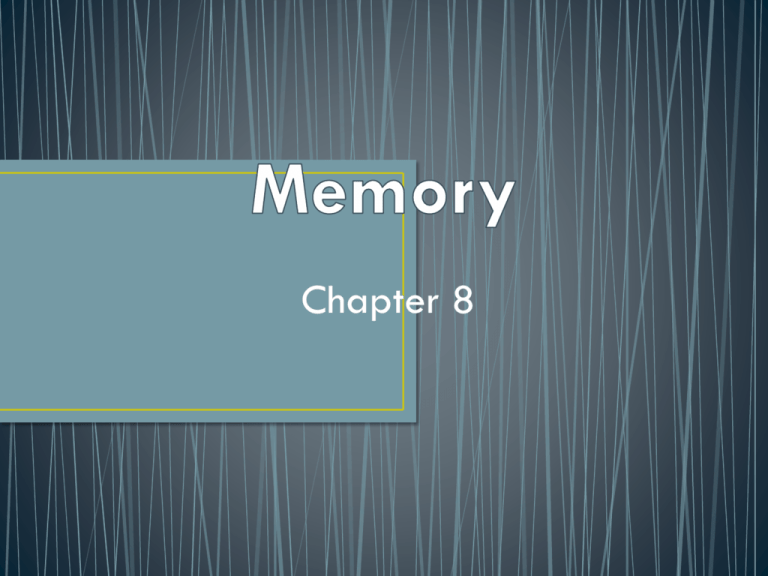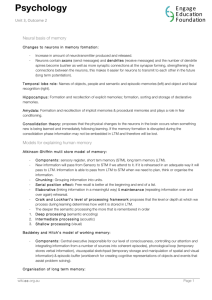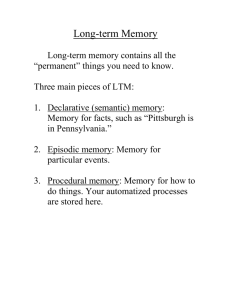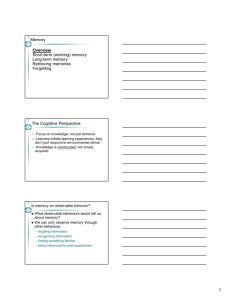Memory Short-Term Memory
advertisement

Chapter 8 • Psychologists have made many correlations between the human brain and computers. They do not think that they operate in the same way. They do not, of course. • With a computer, there are three systems to gaining new information: input, storage, and retrieval. • This is somewhat like how human beings gain new information. When humans process new information, it is raw sensory information that must be coded – in sound, visual, or meaning, that can be used in the next stage of memory. • Then, the information might be transferred into a more permanent memory storage. When the information is needed, it can be retrieved from memory. With computers and human memory, information can be lost. • Some incoming information is stored for only brief periods of time, whereas other information needs to be tucked away permanently. • Stage theory of memory – assumes that we humans have a three-stage memory that meets our need to store information for different periods of time. • We seem to have three memory systems: 1) holds information for brief intervals, 2) for no more than 30 second, and 3) a more permanent memory store. • These are not thought of as three separate systems, but information has to go through one to make it to another. The first memory stage is called the sensory register, then the short-term memory, and long-term memory. • The sensory register is a very brief stage. This is designed to hold each sensory experience until it can be fully processed. • We hold information in this stage long enough to take a snapshot of the information that we need in order to send the important information to the next stage. • The snapshot goes away very quickly, within a couple of seconds. • For auditory information, a recording of the sound that we heard is there for a second or two. • When information is selected for further processing, it is transferred into the short-term memory, or STM. • Just paying attention is enough to transfer it. • Once information has been transferred into short-term memory, a variety of control processes may be applied. Rehearsal and chunking are two examples of these control processes. • Information is lost within the STM in less than thirty seconds unless it is renewed. Generally, it is lost within seconds. • Information in this system can be renewed by mental repetition or by rehearsal of the information. • The information stored can be quite different given memories: the smell of perfume, the notes of melody, the taste of fruit, the shape of a nose, or a list of names. • The storage capacity of STM is quite limited. Psychologist George Miller referred to the STM capacity as seven plus or minus two. • Rarely are people able to hold random bits of numbers of letters of more than 5-9 for very long. • Short-Term Memory works as our working memory. Short term memory is used to update memories that are used or updated. This is why you can’t remember the phone number a friend just gave you a couple minutes ago. Thinking takes up space in the STM and forces the numbers out. Writing out all of the items helps people to remember. • Humans are able to search the STM every time we are trying to recall something. • There are some ways to get around the limited capacity in STM. George Miller created something called memory chunks. • If you are able to group like words together or like numbers, it becomes easier to remember the information. • Social security numbers and bank account numbers are broken up by hyphens. This is because people remember things in chunks. • Long-Term Memory of LTM is the storehouse of information that can be kept for long periods of time. • There are 4 ways that LTM differs from STM. • 1) Information recall – LTM has to be indexed when it comes to storing the information. We retrieve information using cues. It can be a question that can serve as a cue. Only the information related to that cue surfaces. • 2) Information in LTM is stored by meaning or semantic codes. • 3) Information in LTM tends to be permanent. Not all psychologists agree that these memories are permanent. So, if memory is lost in this case it is not because we are forgetting it, but the retrieval cues are not quite there. • 4) Each stage of memory is largely handled by a different part of the brain. STM is a function of the frontal lobes whereas information in the LTM is integrated in the hippocampus and then transferred to the areas of the cerebral cortex involved in language and perception for permanent storage. • It has been proposed that LTM has three storage systems with different properties and based on different brain mechanisms. • 1) Procedural memory – for motor skills and movements. • 2) Semantic memory – memory for meaning without reference to the time and place of learning. • 3) Episodic memory – memory for specific experiences that can be defined in terms of time and space. These seem to be the hardest to recall. • Some psychologists group semantic memory and episodic memory together under the heading declarative memory. These two memory system are alike in that they are easily described in words. • LTM has unlimited capacity, but information has to be categorized. This helps the retrieval of these memories. • Most people will categorically group the new information. • Those that put memorized words into a story generally have a recall of 90% versus those that do not. • Many psychologists believe that memories are linked together, through experience. • The spreading activation model states that people create links between items. E.g. a canary is a bird. • Recall method – a measure of memory based on the ability to retrieve information from longterm memory with few cues. • Recognition method – a measure of memory based on the ability to select correct information from among the options provided. • Relearning method – A measure of memory based on the length of time it takes to relearn forgotten material. This shows that the memory was never completely lost. • This is when the person is able to create some of the information or recall something about the thing the word referred to even when they could not retrieve the full idea. Sometimes, the word or idea would pop into the mind of the student, proving that they did not lose it. • Half of the ideas that we cannot remember or are at the tip of our tongues, can be remembered within a minute. • Sometimes, the order in which we memorize something is as important as the items on the list. When people are asked to memorize items in a list exactly as they appear, they can remember words at the beginning and end, but generally not in the middle. This is called the serial position effect. • The last items remembered tend to still be in STM. The first items are learned because they can be rehearsed enough times where they transfer into LTM. • When people are asked to recall the list after 30 seconds, they tend to forget the last words, too. • Fergus Craik and Robert Lockhart proposed an alternative levels of processing model that suggests the distinction between the short-term memory and long-term memory is a matter of degree rather than separate stages. • They believe there is only one storage beyond the sensory register. They think the ability of the LTM depends upon how well the information is processed as well as being coded for memory. The information will only be kept briefly if the information is seen as shallow. • They believe that if two groups are asked to process a set of words shallowly and deeply with meaning, the participants that processed the information deeply will remember it better. • Why do we remember some events from the day and not others? Does it have to do with the value that we give the memory? • Some psychologists believe that we process memories that will aid in our survival and reproductive fitness. • If the survival theory is correct, how do humans develop the ability to process other information that is not pertinent to survival? • Elaboration – the process of creating associations between a new memory and existing memories. • Relating the information to yourself will help you remember it. This will help improve memory and comprehension. • Information stored for rote memorization will not stay in the LTM for a long time. • What causes forgetting? • There are four theories of forgetting: • 1) Decay Theory – memories that are not used gradually fade away after time. The simple passage of time is a cause of forgetting, both in the sensory register and the STM. It does not seem to affect LTM, though. • 2) Interference theory suggests that forgetting takes place because other information interferes with that information. • Similar memories might interfere with the recollection of memories in LTM. • Proactive interference – interference created by memories from prior learning. • Retroactive interference – interference created by memories from later learning. • Interference is viewed as the most important cause of forgetting, but appears to operate in different ways for different kinds of memory. • In STM, interference tends to overload this capacity. New information can completely knock other information out of STM. • In 1932, Sir Frederic Bartlett came up with a theory called reconstruction theory or schema theory. This suggested that the information stored in LTM is not forgotten, but is sometimes recalled in a distorted, incorrect manner. • Schemas are associative networks consisting of beliefs, knowledge, and expectations. Our recollection in LTM becomes distorted because we recall in many ways that are consistent with our schemas. • If you relay a story about someone, you will tend to remember the negative over the positive. You may even exaggerate the details to explain away the positive aspects that you heard about them. • This theory is interesting to psychologists because episodic memory is harder to remember from LTM than is other memory. We also will tend to give the general idea of the story versus the details. • False memory – remembering an event that did not occur or that occurred in a way that was substantially different from the memory of the event. • Why do you think this is important given a court of law? • Children are less likely to have false memories than adults, perhaps because adults have more complex association networks built up over many years. • Sometimes, human beings will distort memories to make them more consistent. Memory is guided by schemas. Generally, these memories are seen as facts and can be destructive given certain situations. • Motivated forgetting – forgetting that is believed to be based on the upsetting or threatening nature of the information that is forgotten. • Freud believed that the conscious mind dealt with dangerous memories by pushing it into the unconscious, by the act of repression. • What Freud didn’t consider is that emotional arousal can actually improve memories. When shown a list of emotional words, these are easier to remember than neutral words. • Flashbulb memories of extremely emotional events seem to be more vivid and accurate to us, but can be less accurate than memories from everyday events. • There is some kind of change that takes place in the nervous system when something is learned. • The engram – the partially understood memory trace in the brain that is the biological basis of memory. Karl Lashley called this the biological basis of memory. • Hebb created an accurate model of the biological processes responsible for memory. He believed that each new experience activated a unique pattern of neurons in the brain. This activity causes structural changes to occur in those neurons near the synaptic gaps that link them. He termed this synaptic facilitation, which he believed was the biological basis of memory. • Eric Kandel won a Nobel Prize for his research on the role of changes in neural synapses in memory. He did a study of memory on sea snails as they have very simple nervous systems composed of large neurons that are easy to study. • He did an experiment in which he gave the snails shocks, which changed the neurons at the point of the synapses. The amount of the neurotransmitter in the synapse increased. • This showed that Hebb was right in that in some animals the learned response was remembered in the neurons at the synapse. • Some studies suggest that chemical changes in neurons at the synapses that are at the basis for memory are fragile at first, but if nothing disrupts the process, they grow more permanent over the course of a few minutes or hours. This process is called consolidation. • In the chapter on sleep, there is convincing evidence that a period of sleep following learning helps consolidate and protect new memories. This is another reason why overnight study sessions are not efficient. • Recently, it was realized that part of the biological basis of memory involves rapid changes in the expression of genes that influence neurons in the brain. • A number of studies have shown that some genes are turned off or turned on when new memories are formed. • Experience can change how DNA is expressed. • There is evidence that suggests physical changes in neural synapses involved in the LTM, but not in the STM. • There is evidence that different brain structures are involved in the three stages of memory. • Retrograde amnesia – a memory disorder characterized by an inability to retrieve old long-term memory, generally for a specific period of time extending back from the beginning of the disorder. • The only survivor in the Diana, Princess of Wales, still cannot remember what happened in the minutes before and after the car accident. This can be considered retrograde amnesia. • The person is able to create new longterm memories after the incident. The period of memory loss can stay for minutes or days. • Retrograde amnesia is caused by seizures, brain damage, a blow to the head, a highly stressful event, etc. • Anterograde amnesia – disorder of memory characterized by an inability to store and/or retrieve new information in long-term memory. • H.M. is an example of an individual with this condition. He had terrible seizures and his surgeon decided to perform brain surgery in which he injured the memory portion of the brain. He could not remember anything after the surgery. He could remember anything before it, but not after. • H.M. could retain information for about 15 seconds due to an intact STM and could remember it longer if he was allowed to rehearse it. • H.M. could not store new memories of current events, could read the same magazine over and over, and could not remember his father’s death that occurred after his surgery. • His new social friends could not be remembered, but he could recall old stories about his friends before the surgery. He was essentially incapable of forming new friendships with people as he would not remember them if he’d not met them before the surgery. • Persons with this damage have very little trouble with procedural memories, but have trouble with episodic memories. H.M.’s hippocampus was damaged during surgery, which plays a role in episodic memory, but not procedural memory. • Both anterograde and retrograde amnesia are experienced by individuals with Korsakoff’s Syndrome – a brain disorder caused by prolonged loss of the vitamin thiamine from the diet of chronic alcoholics. They will generally partake in confabulation – when they don’t remember something they make it up.









